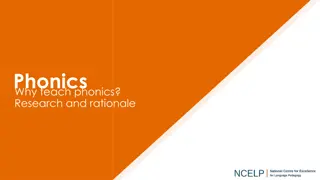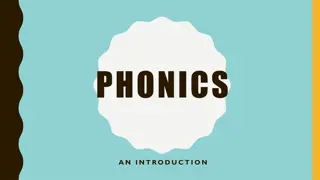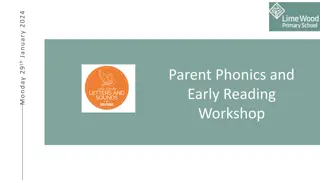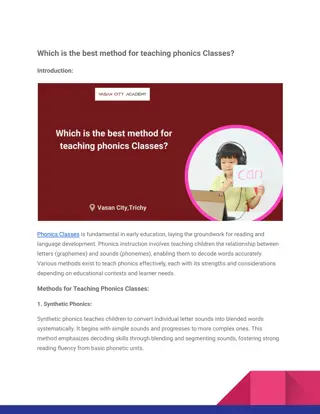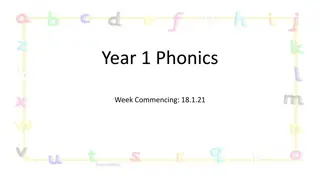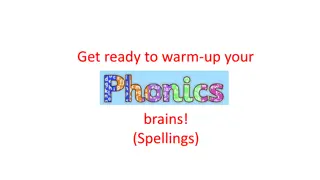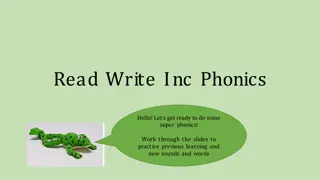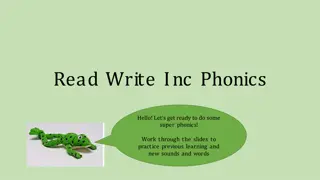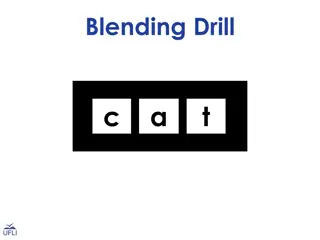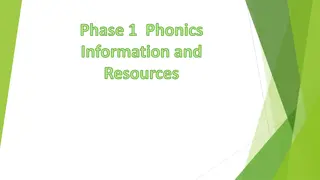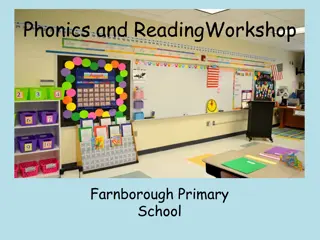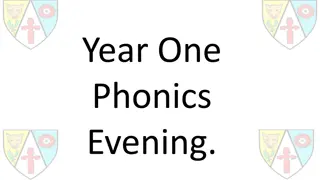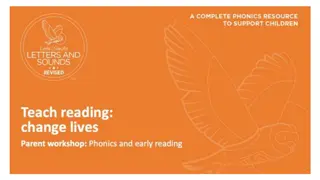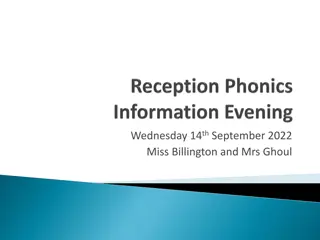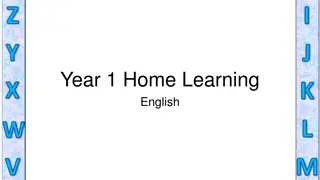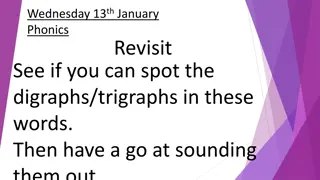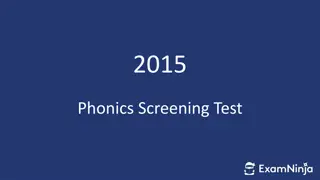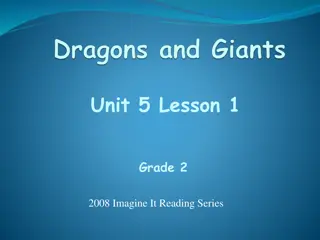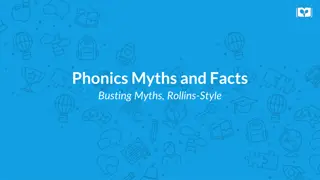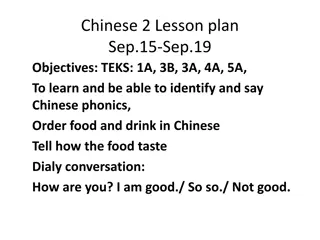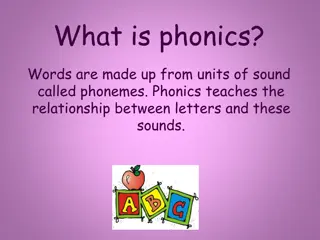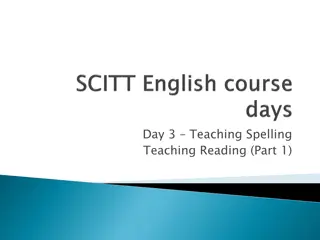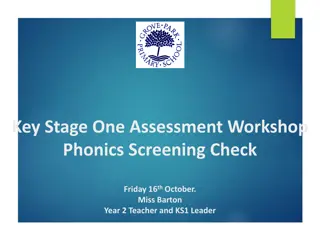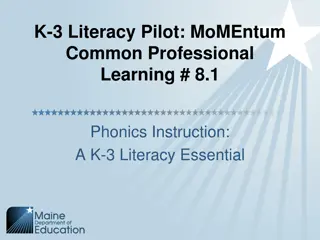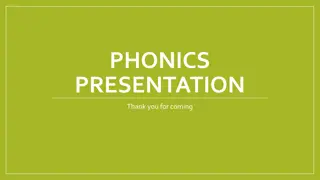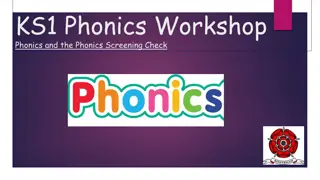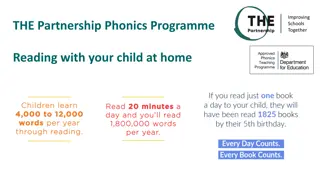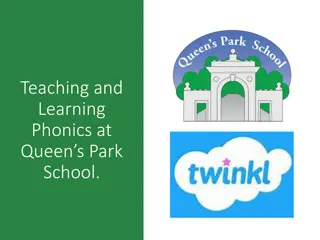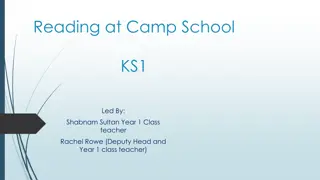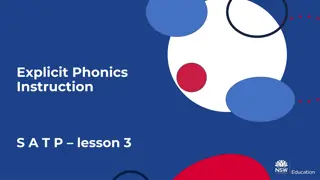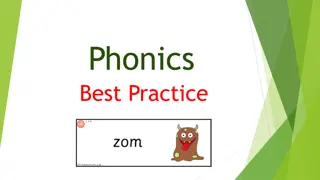Phonics. Why teach phonics?. Research and rationale.
Teaching phonics, the relationship between letters and sounds, is essential in language learning to improve reading skills. This content explores the significance of phonics instruction, its effectiveness in L2 learning, and the role of phonological decoding. It also discusses the importance of accu
2 views • 33 slides
Phonics Practice Activities for Elementary Students
Engage elementary students in phonics practice with various activities like identifying initial, medial, and final sounds, blending phonemes to form words, and changing sounds to create new words. The provided examples and word lists enhance students' understanding and application of phonics concept
6 views • 14 slides
Phonics: An Introduction to Systematic Synthetic Approach
Phonics is a fundamental method for teaching children to read by associating letters with their corresponding sounds. This systematic synthetic approach gradually introduces children to various ways of spelling sounds, building upon their existing knowledge. Implementing schemes like Little Wandle h
4 views • 23 slides
Parent Phonics and Early Reading Workshop - Monday 29th January 2024
Explore the exciting world of phonics and early reading in the upcoming Parent Workshop on Monday, 29th January 2024. Dive into the fundamentals of phonics, terminology recap, Phase 3 learning objectives, tricky words, reading longer words, order of learning, and writing activities. Get ready to sup
2 views • 14 slides
2024 Phonics Screening Test Slides
These slides provide visual aids for the 2024 Phonics Screening Test, featuring images and descriptions to assist in phonics assessment. Each slide is designed to help educators and students with various phonics concepts and exercises.
0 views • 41 slides
MIPS CPU Design Using Verilog and Instruction Set Architecture Overview
Explore the world of MIPS CPU design using Verilog with a deep dive into Instruction Set Architecture (ISA), SPIM instruction formats, addressing modes, and more. Learn about the key components such as Program Counter (PC), Instruction Memory (IM), Register Files (RF), Arithmetic Logic Unit (ALU), D
1 views • 29 slides
_Which is the best method for teaching phonics Classes_
Phonics Classes is fundamental in early education, laying the groundwork for reading and language development. Phonics instruction involves teaching children the relationship between letters (graphemes) and sounds (phonemes), enabling them to decode
0 views • 3 slides
Year 1 Phonics - Learning Sounds and Words
The Year 1 Phonics program for the week commencing 18.1.21 focuses on learning Phase 5 sounds, including the 'aw', 'wh', and 'ph' sounds. Students practice reading and writing words with these sounds, play interactive games, and form sentences integrating the learned sounds. Engaging activities like
2 views • 22 slides
Phonics Detective Fun: Digraphs and Word Blending Activities
Join the Phonics Detective and warm up your brains with exciting activities focusing on digraphs, word blending, and sound recognition. Explore words like boat, moat, and flow to improve phonics skills. Identify where the digraph appears in words and practice blending sounds. Test your knowledge wit
0 views • 20 slides
Fun Phonics Practice with Read Write Inc.
Dive into a super phonics session with Read Write Inc.! Practice speed sounds, review red words, learn new sounds, and spot words in sentences. Enhance your phonics skills with engaging activities and interactive learning materials.
0 views • 11 slides
Super Phonics Practice with Read Write Inc Phonics
Join in for an engaging session to work on previous and new sounds and words through interactive slides, including Speed Sounds, Red Words, reviewing word patterns, practicing new sounds like "ew" and "oo," and identifying grotty graphemes in red words. Enhance your phonics skills and spot new words
0 views • 12 slides
Overview of Little Wandle Letters and Sounds Programme
Little Wandle Letters and Sounds Revised is a government-recommended phonics and early reading programme designed to help children fluently decode and read texts using phonics by the end of Year 1. Parents play a vital role in supporting children's reading development, as fluency by age 6 correlates
1 views • 18 slides
Blending Drill for Phonics Practice
Engage students in a fun and interactive blending drill activity to enhance phonics skills. This resource includes grapheme cards for practicing initial, medial, and final sounds, allowing students to build and blend words. Explore a variety of word changes and continue the learning process with eng
0 views • 9 slides
Phase 1 Phonics: Developing Early Listening and Speaking Skills
Phase 1 Phonics, the initial stage of Letters and Sounds, focuses on enhancing children's speaking and listening abilities to prepare them for phonics work in Phase 2. This phase emphasizes tuning in to sounds, listening and remembering sounds, and talking about sounds through various activities des
3 views • 17 slides
Phonics and Reading Workshop at Farnborough Primary School
Explore the essence of phonics, encompassing the 44 sounds of the English language, blending skills for reading, tricky words, the Year 1 phonics screening test, and supporting reading at home. Learn the fundamentals of phonics, the alphabet, letter sounds, blending techniques, and practical exercis
0 views • 39 slides
Effective Phonics Teaching Strategies for Year One Students
Exploring the fundamentals of phonics in Year One, this resource delves into phonics screening checks, blending techniques, terminology, common phonic sounds, the importance of pure sounds, and practical tips on implementing phonics teaching in the classroom. Discover differentiated group sessions,
0 views • 20 slides
Maximizing Literacy Achievement: Effective Instruction Planning Strategies
Timothy Shanahan from the University of Illinois at Chicago discusses key considerations for planning effective literacy instruction, including scheduling, amount of instruction, content to be taught, and the timing of instruction. Shanahan emphasizes the importance of providing ample literacy instr
1 views • 19 slides
Little Wandle Phonics Programme for Early Reading Success
Little Wandle Letters and Sounds Revised is a government-recommended phonics programme aimed at ensuring children can fluently decode and read using phonics by the end of Year 1. With daily phonics teaching, group reading, interventions, and assessments, parents play a crucial role in supporting the
0 views • 24 slides
Phonics Learning Program for Children
Explore a comprehensive phonics learning program for children featuring Miss Billington and Mrs. Ghoul. Discover the synthetic phonics approach with 44 sounds, digraphs, and more. Learn about teaching methods, including Fred Talk and Fred Fingers, to enhance reading and writing skills. Find guidance
0 views • 17 slides
Year 1 Home Learning English - Phonics and Reading Activities
Enhance your child's English skills at home with Year 1 home learning activities focusing on phonics, reading, and writing. Explore Phase 5 graphemes, tricky words, sight reading, and fun phonics games to improve literacy. Engage in reading activities with the class storybook "Handa's Surprise" by E
1 views • 19 slides
Wednesday 13th January Phonics Revisit: Digraphs and Tricky Words Practice
Explore digraphs and tricky words in phonics practice - spot and sound out digraphs/trigraphs, decode upside down words, learn new sounds like "ir," and practice phoneme spotting. Engage in memory tests and find mistakes to enhance phonics skills.
0 views • 12 slides
Visual Collection of Educational Materials for Phonics Screening Test
This comprehensive collection features a series of visual aids for various aspects of the Phonics Screening Test, including slides on phonics, FIP, PON, HAB, ULB, DACK, CHOB, NURT, QUEET, PLAP, FROIN, MELP, HEENT, SHED, LONG, SOIL, CHART, CRAB, FRESH, WINK, SHUTS, YAIR, BLIES, KEAM, WHAPE, and BRAFT
0 views • 41 slides
Engaging Phonics Activities for Grade 2 Reading Series
Delve into exciting activities from Day One to Phonics and Fluency, exploring themes like baseball games, vocabulary building with word families, and phonics practice with words like hawk, draw, vault, and more. With engaging images and a focus on language development, this resource offers a fun and
0 views • 124 slides
Debunking Phonics Myths: A Closer Look at Reading Instruction
Debunk common myths surrounding phonics instruction with evidence-based facts. Understand the importance of explicit and systematic phonics teaching for reading proficiency and comprehension. Learn how decoding words, orthographic mapping, and rich oral language development play key roles in effecti
0 views • 16 slides
Chinese Lesson Plan: Phonics, Food Ordering, Conversations
This Chinese lesson plan covers phonics identification, food and drink ordering, and daily conversations. Students will learn Chinese phonics, order food and drinks, describe food tastes, and engage in daily conversations. The plan includes activities like Moon Festival presentation, voting for the
0 views • 19 slides
Exploring Grammar and Phonics in the Victorian Curriculum
This insightful discussion delves into the integration of grammar and phonics in the Victorian Curriculum, offering practical approaches for educators. It explores the importance of phonics, phonemic awareness, and sound-letter knowledge in language development. The content emphasizes the value of u
0 views • 37 slides
Understanding Phonics: The Key to Reading Success
Phonics is a method of teaching the connection between sounds and letters to help children learn to read and spell. It involves recognizing phonemes, blending sounds to form words, and assessing proficiency through screenings. The phases of phonics progress from basic letter sounds to more complex d
0 views • 30 slides
Exploring Effective Phonics Teaching and Spelling Conventions through History
Explore the development of effective phonics teaching and spelling conventions through reflective logs and historical context. Discover the impact of phonics sessions on understanding and teaching practices, delving into Old English to modern-day practices. Learn about the evolution of language and
0 views • 57 slides
Phonics Screening Check Overview for Year 2 Students
The Phonics Screening Check is a statutory assessment for Year 1 students that has been adapted for Year 2 due to Covid-19 disruptions. It involves reading a list of 40 words, both real and nonsense, to assess children's phonics skills. The check will take place in a quiet setting and aims to determ
0 views • 10 slides
Enhancing Phonics Instruction for K-3 Literacy Educators
Explore common phonics terminology, strategies to deepen decoding skills, blending techniques, word building activities, and instructional dictation to support students in phonics instruction. Discover the language of phonics, progression phases, and effective instructional strategies in this compre
0 views • 23 slides
Effective Phonics Teaching Strategies for Year One Children
Explore the structured phonics teaching programme aiming to meet Year One standards, emphasizing the importance of phonics for reading and writing skills development. Engage with daily interactive activities, games, and partner work sessions for 20 minutes each day. Learn key definitions such as gra
0 views • 14 slides
Understanding Phonics: A Key to Reading Success in Year 1
Phonics is a fundamental approach to teaching reading by breaking down words into sounds (phonemes) and blending them together. It aids in developing essential reading and spelling skills in children, leading to a positive school experience. The 44 phonemes and corresponding graphemes play a crucial
0 views • 24 slides
Understanding Phonics in KS1: A Comprehensive Overview
Explore the world of phonics in the context of KS1 education, covering essential concepts like phonemes, graphemes, blending, segmenting, and more. Discover how phonics instruction helps children develop crucial reading and spelling skills, complementing other literacy strategies to foster a love of
0 views • 16 slides
Understanding Phonics: The Key to Reading Success
Phonics is the crucial link between letters and sounds, essential for children's reading skills. It involves learning the phonemes, graphemes, and letter combinations that make up words. A structured approach using programs like Jolly Phonics and Letters and Sounds helps children articulate sounds,
0 views • 21 slides
Embedded Computer Architecture - Instruction Level Parallel Architectures Overview
This material provides an in-depth look into Instruction Level Parallel (ILP) architectures, covering topics such as hazards, out-of-order execution, branch prediction, and multiple issue architectures. It compares Single-Issue RISC with Superscalar and VLIW architectures, discussing their differenc
0 views • 49 slides
Enhancing Literacy Skills with Improving Schools Together Phonics Programme
Empower your child's reading abilities with the Partnership Phonics Programme by Improving Schools Together. Through phonics, children learn to match sounds to letters, blend them to read words, and progress from simple to complex phonic skills. Discover the importance of reading at home and how it
0 views • 18 slides
Teaching and Learning Phonics at Queen's Park School
Understand the importance of phonics in reading and writing education at Queen's Park School. Learn about phonics basics, terminology, and the Twinkl Systematic Synthetic Phonics Programme used. Discover how to support your child's learning and get insights into the complexity of English phonetics.
0 views • 20 slides
Reading Instruction Methods at Camp School: A Comprehensive Overview
Explore how reading is taught at Camp School, focusing on phonics, guided reading, whole-class reading, and English sessions. Discover the structured approach to phonics instruction, including phases, vocabulary, and techniques like segmenting and blending. Dive into how Year 1 students learn Phase
0 views • 13 slides
Explicit Phonics Instruction S.A.T.P Lesson 3
Explore the explicit phonics instruction lesson focusing on the S.A.T.P graphemes representing phonemes to enhance reading and spelling skills. Follow the NSW Department of Education's learning intention and success criteria to effectively use graphemes in reading and writing words. Engage with a se
0 views • 26 slides
Effective Phonics Teaching Strategies for Primary School Educators
Implementing best practices in phonics education is crucial for enhancing student learning outcomes. This guide covers organizing teaching sessions, monitoring progress, training resources, demonstration activities in Year 1, and word sections for comprehensive phonics instruction. Key tips include
0 views • 8 slides
